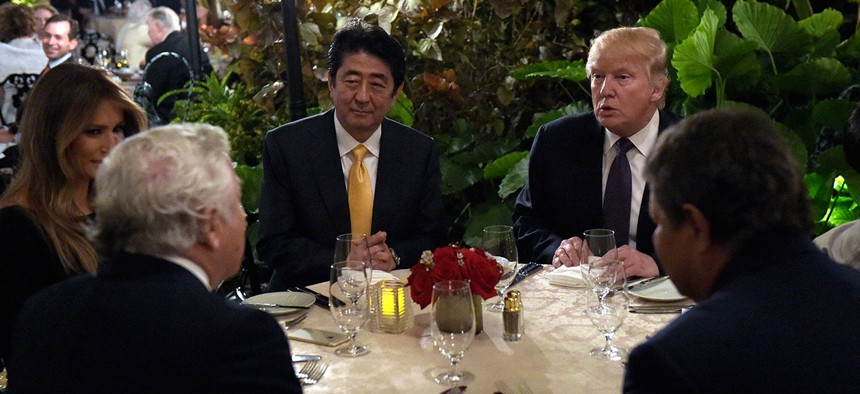
Donald Trump dines with Shinzō Abe at Mar-a-Lago in February. Susan Walsh/AP
A List of the Trump Administration’s Security Breaches So Far
Revealing classified information to top Russian officials was but the latest in a string of lapses since Trump took office.
President Donald Trump’s reported disclosure of classified information to Russia’s foreign minister and US ambassador last week is but the latest in a string of notable security breaches to have taken place in the less than four months since he took office.
With even top Republicans—such as Bob Corker, chair of the Senate foreign affairs committee—losing patience, we bring you a list of the Trump administration’s security snafus to date. At least, those that have been publicly reported.
BOB CORKER: "The White House has got to do something soon to bring itself under control and in order. It's got to happen."
— Sahil Kapur (@sahilkapur) May 15, 2017
Not firing national security adviser Mike Flynn for 18 days
It took Trump 18 days to fire national security adviser Mike Flynn, after acting attorney general Sally Yates had warned the White House counsel, Don McGahn, that Flynn was liable to blackmail by Russia because he hadn’t fully disclosed details of his conversations with the Russian ambassador before Trump took office. This prolonged his exposure to sensitive information, and could conceivably have given him more time to hand over state secrets.
Using Mar-a-Lago as an al fresco situation room
Trump was dining with Japanese prime minister Shinzo Abe in his private members’ club in Florida, Mar-a-Lago, when he took a call about North Korea launching a missile test. Instead of immediately going somewhere secure, Trump held the meeting in the view of guests like these:

The same guest also got up close and personal with the man who carries the nuclear launch information for the president. (The Pentagon acknowledged that this is unusual but not illegal or against official protocol.)
Using a non-secure Android phone
For at least the early days of his presidency, Trump was using an Android phone believed to be made in 2012—which no longer receives updates. That means it can easily be hacked, and turned into a live bug at any time.
Leaving a secure document pouch out with the key in it
Never leave a key in a classified lockbag in the presence of non-cleared people. #Classified101 (Original Photo @AP https://t.co/F4KaPbX9Hw) pic.twitter.com/4GmKK8dp5K
— Martin Heinrich (@MartinHeinrich) February 10, 2017
Martin Heinrich, a Democratic senator, spotted a security breach in a press photo: A lockbag, or pouch containing classified documents, with the key still in it, sitting on Trump’s desk during a meeting in the Oval Office. That, according to Heinrich, shouldn’t be done around people without security clearances (such as journalists). Security experts consulted by Politico said that more generally, leaving documents out on his desk to be photographed by the press was not a good security practice.
Trump’s bodyguard revealing the defense secretary’s phone number
Trump’s bodyguard, Keith Schiller, was photographed walking on White House grounds carrying a sheaf of papers with a sticky note attached that read “Jim, Mad Dog, Mattis,” along with a phone number. A reporter who dialed the number got defense secretary James Mattis’s voicemail.
Pre-announcing Jared Kushner’s visit to a war zone
Visits by top officials to dangerous regions are never usually announced ahead of time, as it opens airports up to greater risk of terror attacks. However, when Jared Kushner, Trump’s adviser and son-in-law, visited Iraq, the White House got its wires crossed, telling reporters that he had arrived when he was still in the air.
Revealing that the CIA had been hacked
Trump told Fox News that the CIA had been hacked during the Obama years, with “a lot of things taken.” This had never been revealed to the public. Adam Schiff, the top Democrat on the House Intelligence committee said: “For anyone else to do what the president may have done, would constitute what he deplores as ‘leaks.’”
Letting a Russian state photographer into the Oval Office
A former deputy CIA director said “it was not” a sound decision to allow a photographer from Russian state news agency Tass into the Oval Office with his camera—on the same occasion Trump revealed the classified information to Russia’s foreign minister and US ambassador. The Russian state press is often seen as an arm of the Russian government. American press were denied access to the meeting.






